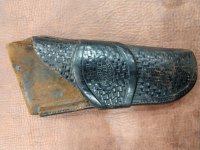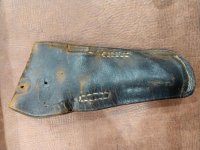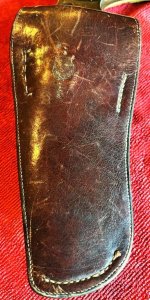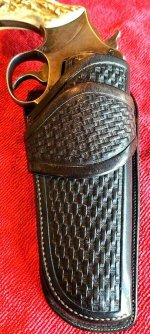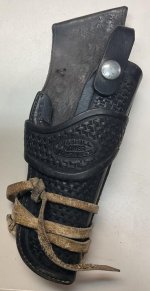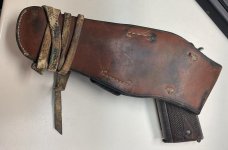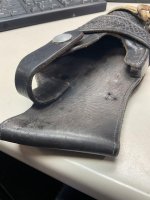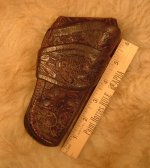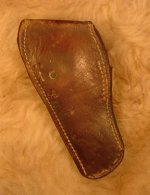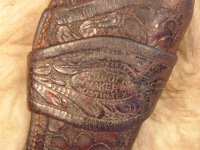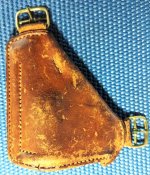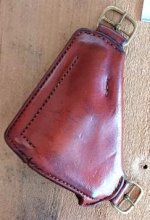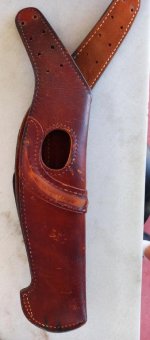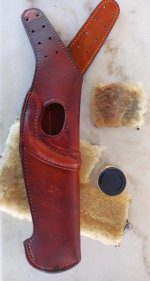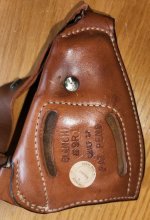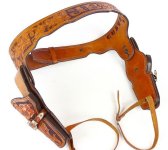This holster was on a table of a friend in New Mexico. Note the unusual loop stitching 2 places on the back skirt of the holster. I have a number of Brill holsters and have not seen this stitch pattern before. Others may have...
You are using an out of date browser. It may not display this or other websites correctly.
You should upgrade or use an alternative browser.
You should upgrade or use an alternative browser.
A mangled but none the less interesting A.W. Brill holster
- Thread starter Papa Lee
- Start date
Register to hide this ad
This holster was on a table of a friend in New Mexico. Note the unusual loop stitching 2 places on the back skirt of the holster. I have a number of Brill holsters and have not seen this stitch pattern before. Others may have...
That is odd, Lee!
Larry
rednichols
Member
- Joined
- Jul 24, 2012
- Messages
- 2,745
- Reaction score
- 8,482
You had me at 'Brill'  .
.
Look again, the original stitchlines have been picked out and the ones you don't recognize were added, to create a wider belt loop. Not how Brills were equipped with wider loops; the fold was moved.
And you didn't notice the hack job of the holster pocket itself? All its retention has been cut away. It used to be a Kluge scabbard.
Look again, the original stitchlines have been picked out and the ones you don't recognize were added, to create a wider belt loop. Not how Brills were equipped with wider loops; the fold was moved.
And you didn't notice the hack job of the holster pocket itself? All its retention has been cut away. It used to be a Kluge scabbard.
Attachments
RED, I guess I should have put on my cheaters and looked closer at the picture to see the evidence of the original stitching;-). Of course I noticed the cutaway, that's why I called it mangled...The toe was mangled too.
- Joined
- Apr 13, 2012
- Messages
- 1,395
- Reaction score
- 7,125
Is it just me, or does the impression on the back of the holster resemble a Mauser HSC?
Makes you wish it could tell it’s story.
Makes you wish it could tell it’s story.
You had me at 'Brill'.
Look again, the original stitchlines have been picked out and the ones you don't recognize were added, to create a wider belt loop. Not how Brills were equipped with wider loops; the fold was moved.
And you didn't notice the hack job of the holster pocket itself? All its retention has been cut away. It used to be a Kluge scabbard.
Yeah Red, you couldn’t miss the “Bubba” job on the holster pocket! I noticed it only having a single welt, being a Kluge holster. Obviously, Bubba didn’t care about the collectibility of this early Brill and ruined it, which should be a “hanging offense”!
Larry
Another interesting Brill
For a Colt 1911. Currently on an auction site. The seldom seen extended shank model. The only other one like this I can recall seeing was pictured in Holstory (for a SAA Colt).
My friend Drexel Doran tells me that the extended shank holsters were some of the last Brills made, probably in the 1950's. He avoids them.
For a Colt 1911. Currently on an auction site. The seldom seen extended shank model. The only other one like this I can recall seeing was pictured in Holstory (for a SAA Colt).
My friend Drexel Doran tells me that the extended shank holsters were some of the last Brills made, probably in the 1950's. He avoids them.
Attachments
Last edited:
rednichols
Member
- Joined
- Jul 24, 2012
- Messages
- 2,745
- Reaction score
- 8,482
For a Colt 1911. Currently on an auction site. The seldom seen extended shank model. The only other one like this I can recall seeing was pictured in Holstory (for a SAA Colt).
My friend Drexel Doran tells me that the extended shank holsters were some of the last Brills made, probably in the 1950's. He avoids them.
I think your friend doesn't actually know what he's talking about. Brills of the 1950s, for example, were made by N.J. Rabensburg and therefore are the best of all the Brills. He even spoke of making them in his interview during retirement. Notice that the belt loop tunnel is completed by a pair of 'X' stitches because the cuff has stayed in place and can't complete the tunnel as it does on high ride Brills.
IMHO these extended shank holsters were made largely in the late 1930s, because they have the 'transition' muzzle stitching of Kluge on the basic N.J. configuration, while both men worked at Brill before Kluge retired 1940ish. Just a deduction, can't prove it; but can prove that N.J. did not use the straight Kluge muzzle when he made the Nelson holsters in the 1950s
Another old A.W. Brill holster
This old time worn, abused, riveted, and restitched Brill fits a 4" K Frame M&P. Possibly the only redeeming feature is that is is floral carved instead of the more common basketweave. Good for nothing but display now.
This old time worn, abused, riveted, and restitched Brill fits a 4" K Frame M&P. Possibly the only redeeming feature is that is is floral carved instead of the more common basketweave. Good for nothing but display now.
Attachments
Doug M.
Member
Collectibility is never a relevant criterion, and sure as heck did not matter at the time of the alterations. The only thing that matters is utility for the intended purpose by the person who had it at the time.Obviously, Bubba didn’t care about the collectibility of this early Brill and ruined it, which should be a “hanging offense”!The only thing that could possibly make the alterations to the holster acceptable is if, like Tim said, it has a fantastic story behind it.
Larry
I have lots of different holsters for different circumstances (like many, some turned out to be not so useful); since the main point is to carry without detection, no one should see your holster as a general rule. (I loathe OC under almost all conditions - I want to never be perceived as being armed unless it becomes necessary to present the sidearm.)
This old time worn, abused, riveted, and restitched Brill fits a 4" K Frame M&P. Possibly the only redeeming feature is that is is floral carved instead of the more common basketweave. Good for nothing but display now.
NICE one, Lee! I don’t know that I’ve ever seen a floral carved one for sale before. I probably have, but was unobtainable because of price. I wonder what Blackrock would do for that one?
Larry
Thanks Larry. These photos were taken after a treatment with Blackrock. It looked much worse before.
rednichols
Member
- Joined
- Jul 24, 2012
- Messages
- 2,745
- Reaction score
- 8,482
Thanks Larry. These photos were taken after a treatment with Blackrock. It looked much worse before.
I'm not a fan of Blackrock. It is mostly water and radiator antifreeze. Personally and professionally I use Fiebing's Tan Kote that is readily available in small bottles on eBay. Rub it in with a sheepswool pad once and no more than twice. For holsters that show a bit of surface disintegration it has the advantage of (1) light cleaning and (2) a lacquer content to bind the loose surface together again. Below, before and after Berns-Martin:
Attachments
rednichols
Member
- Joined
- Jul 24, 2012
- Messages
- 2,745
- Reaction score
- 8,482
Thanks for that, Onomea, here's a Lawman that was in a similar condition to yours, leather condition wise.
In reading over Blackrock's literature it appears to be intended for finished (painted) leathers in which case it can do no harm, does actually clean, and leaves a temporary shine. But in that case, such as with boots (or J.M. Bucheimer painted leather) it cannot penetrate the painted finish so does not nourish the leather.
In reading over Blackrock's literature it appears to be intended for finished (painted) leathers in which case it can do no harm, does actually clean, and leaves a temporary shine. But in that case, such as with boots (or J.M. Bucheimer painted leather) it cannot penetrate the painted finish so does not nourish the leather.
Attachments
Red, I don’t know if it actually does any good, but when I apply Blackrock with my finger, doing one section at a time. Immediately after application, I go over the area with a hairdryer. It seems to force the Blackrock into the leather and makes it flow behind snaps, etc. I let it sit for a while, and if I see any “wet” looking spots, I’ll hit them with the hairdryer again. I’ll do the whole holster like this and then let it sit a while longer, making sure it doesn’t have a sticky feel to it. Lastly, I brush it with my large horsehair shoe brush. Sometimes, I may even hit them with a coat of Renaissance Wax too.Thanks for that, Onomea, here's a Lawman that was in a similar condition to yours, leather condition wise.
In reading over Blackrock's literature it appears to be intended for finished (painted) leathers in which case it can do no harm, does actually clean, and leaves a temporary shine. But in that case, such as with boots (or J.M. Bucheimer painted leather) it cannot penetrate the painted finish so does not nourish the leather.
I’ve done leather holsters, pistol cases, wallets, boots with good results. My stuff is basically in a collection and not used at all. My holsters that are used aren’t used hard. Red, I know that you have forgotten more that I have ever known as far as holsters go, but this is my system.
Larry
Last edited:
rednichols
Member
- Joined
- Jul 24, 2012
- Messages
- 2,745
- Reaction score
- 8,482
Red, I don’t know if it actually does any good, but when I apply Blackrock with my finger, doing one section at a time. Immediately after application, I go over the area with a hairdryer. It seems to force the Blackrock into the leather and makes it flow behind snaps, etc. I let it sit for a while, and if I see any “wet” looking spots, I’ll hit them with the hairdryer again. I’ll do the whole holster like this and then let it sit a while longer, making sure it doesn’t have a sticky feel to it. Lastly, I brush it with my large horsehair shoe brush. Sometimes, I may even hit them with a coat of Renaissance Wax too.
I’ve done leather holsters, pistol cases, wallets, boots with good results. My stuff is basically in a collection and not used at all. My holsters that are used aren’t used hard. Red, I know that you have forgotten more that I have ever known as far as holsters go, but this is my system.
Larry
I respect your viewpoint Larry. We should consider that the ingredients of Black Rock which are water, machine oil, and antifreeze, are suitable to 'boots on the ground' but can actually be harmful to holsters made of full grain leather. Such leather darkens because it absorbs the ingredients but they cannot nourish it. What we want, if anything, for gunleather is that it look better than when we started, otherwise we'd just use neatsfoot oil which is what was used to colour the leather in the first place! Most gunleather, though, has a finish on it already so instead of oil, which will nourish but won't shine, I use Tan Kote for the beneficial blending of all the flaws in the surface that appeared over extended use, then to give a 'not new but nice' gloss that resists light rain.
Bianchi products like this one were coloured with neatsfoot oil (wiped on the product with a sponge, and allowed to rest while the oil sought it's natural levels all across the product, then touched up until the ideal colour was achieved) then hand rubbed with Fiebing's Harness Dressing; a colourless product which is no longer made by Fiebing's. No lacquer, that was abandoned in the '70s and replaced by the method I just described, after a series of focus groups found the lacquered finish to be disliked. An old Bianchi product won't benefit from reapplying the oil (won't soak in) but will benefit from Tan Kote to return the original 'look'. Anything engraved will darken because the Tan Kote soaks in. But it DOES benefit the holster:
Attachments
Similar threads
- Replies
- 4
- Views
- 756
- Replies
- 2
- Views
- 703
- Replies
- 2
- Views
- 677

